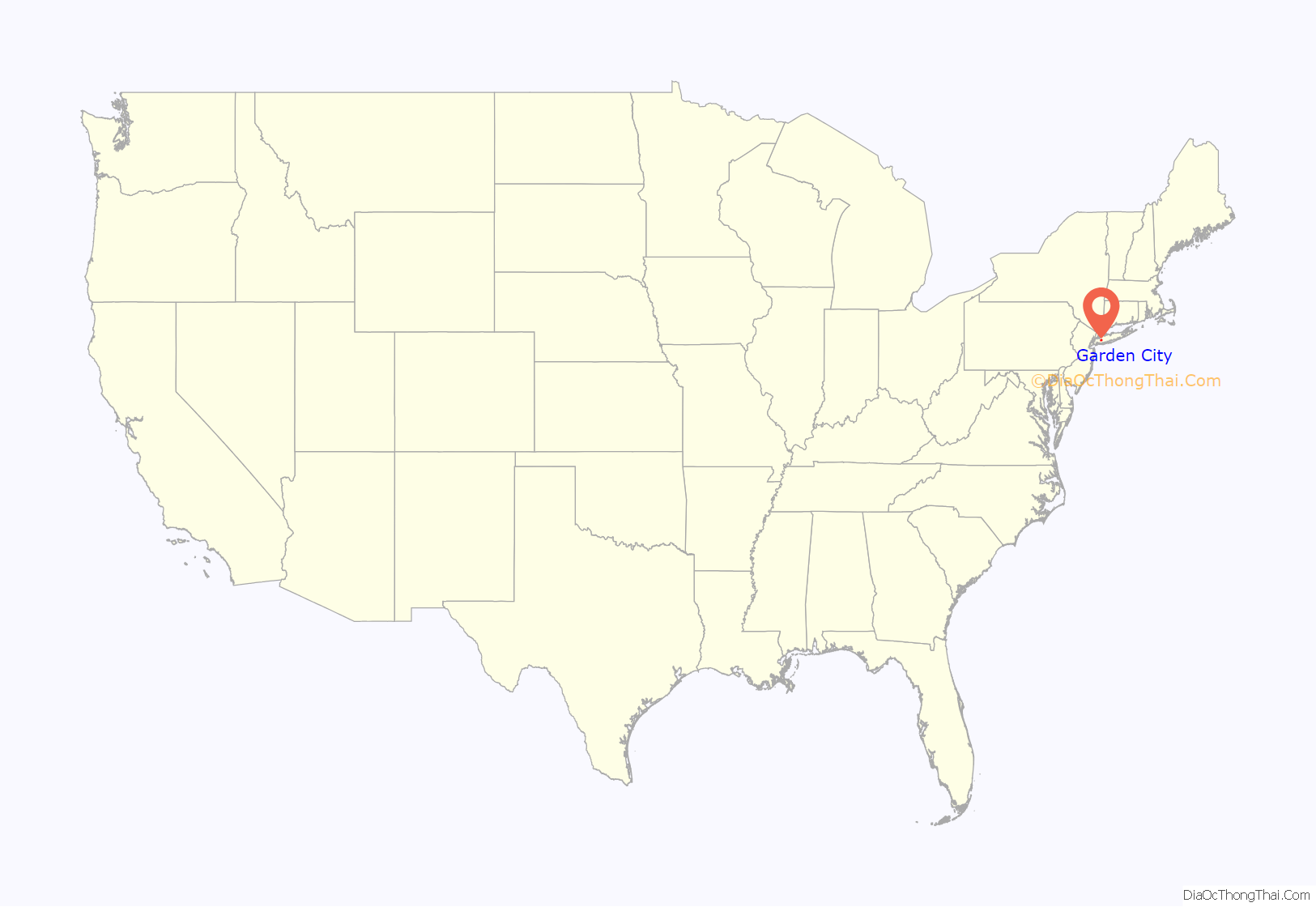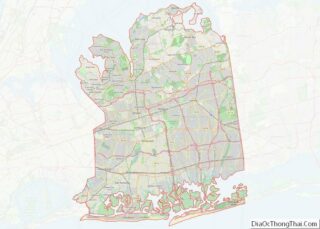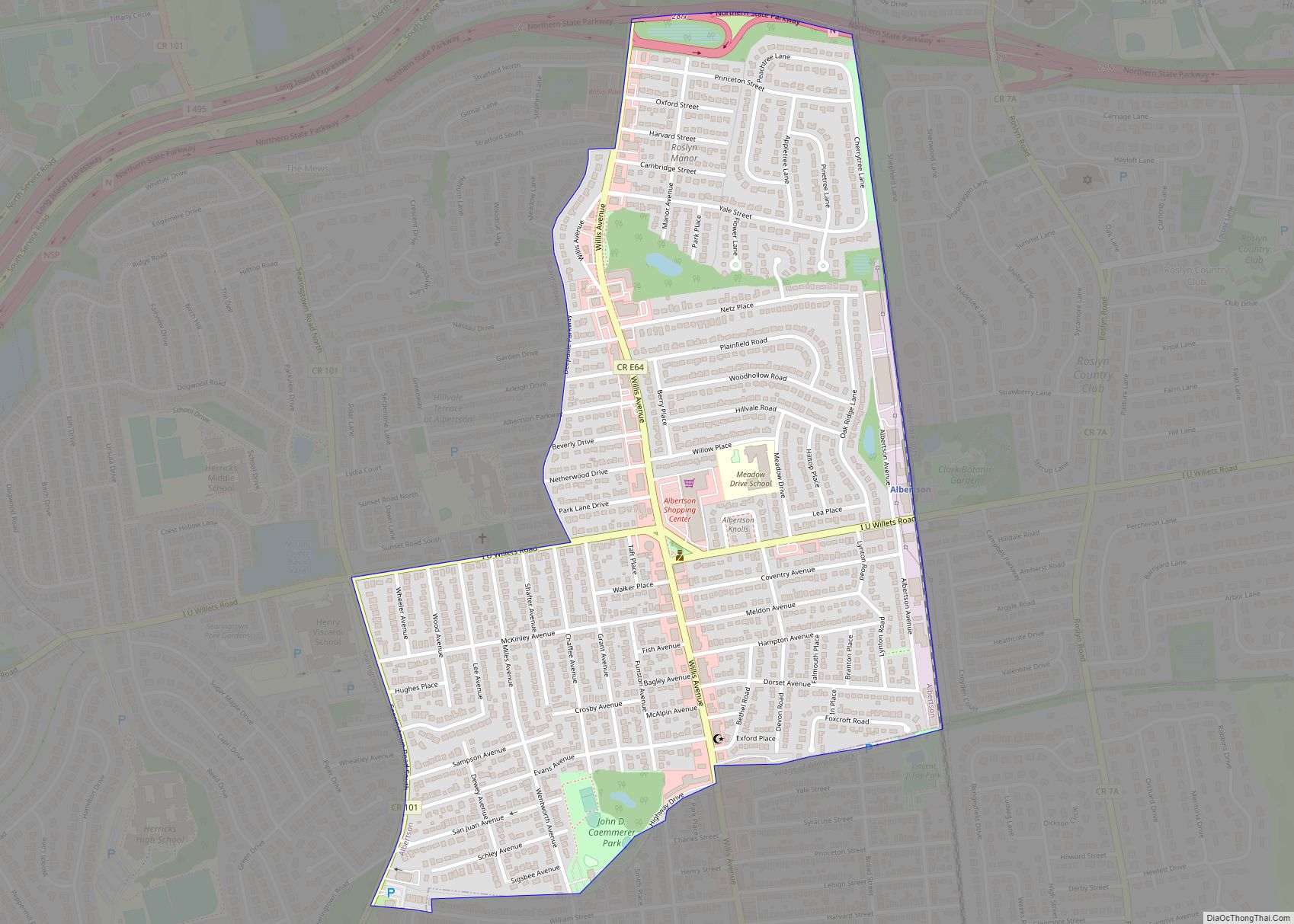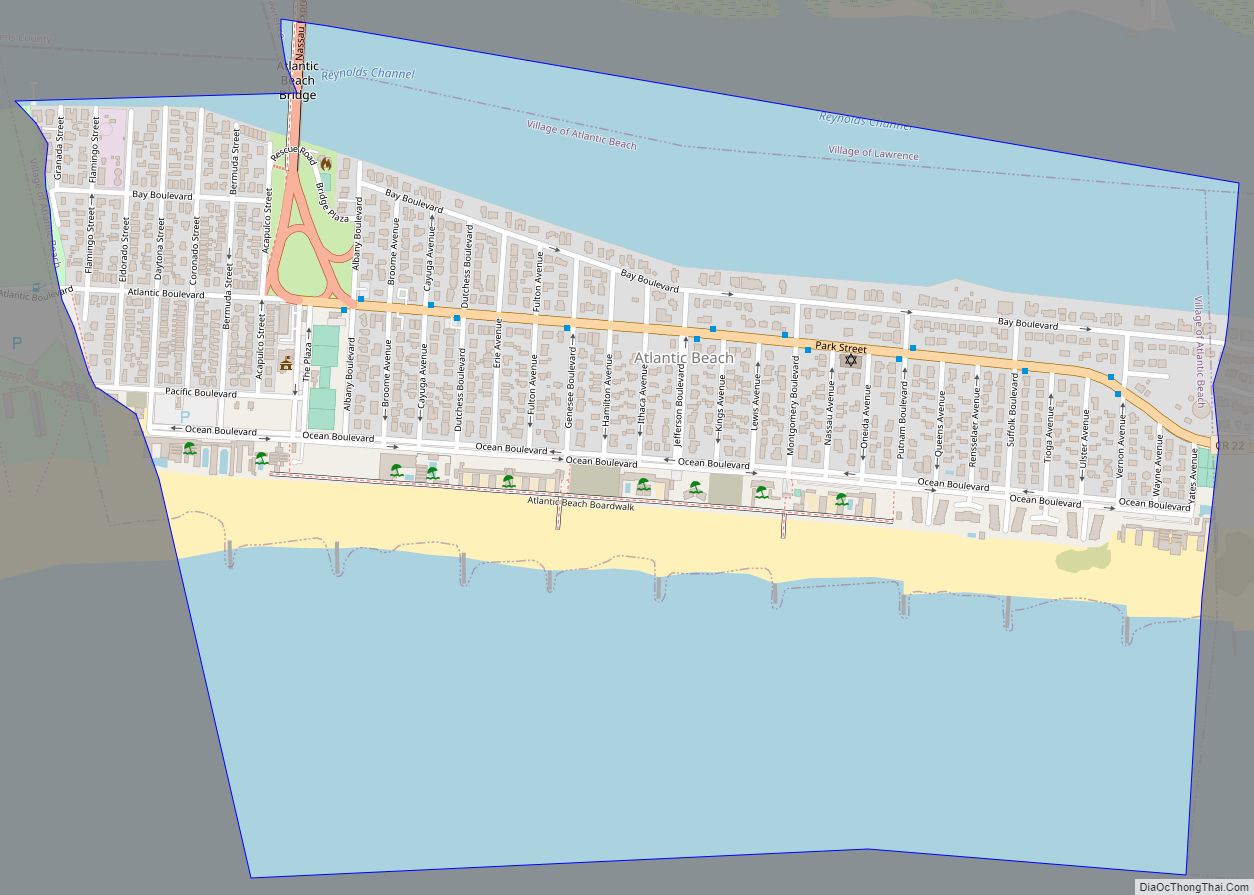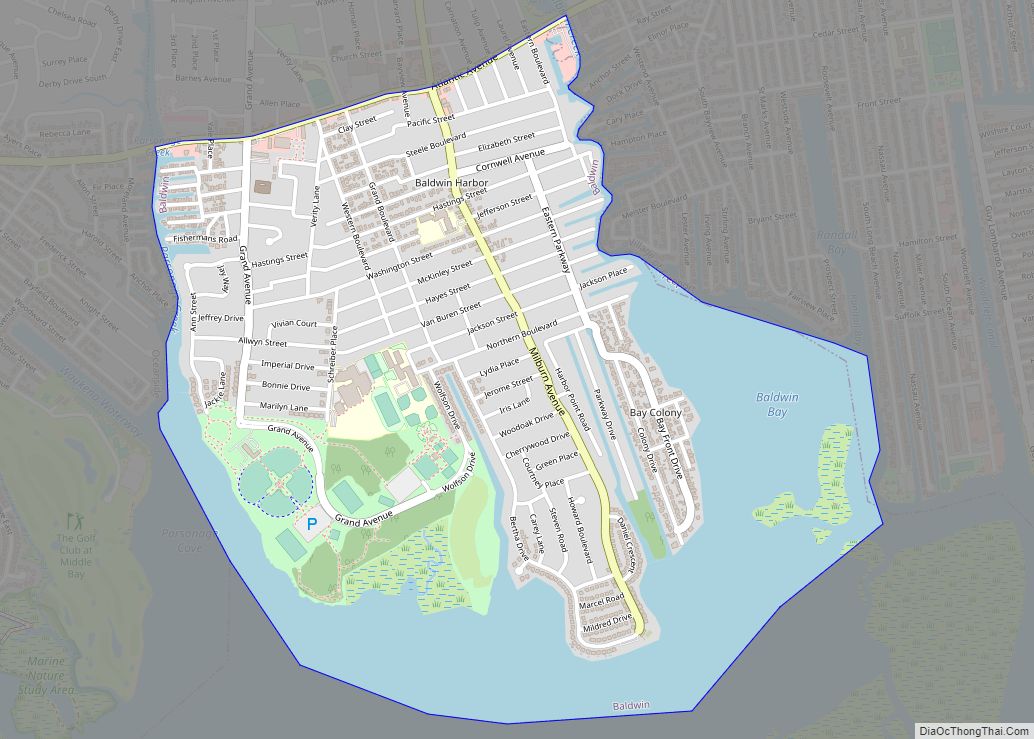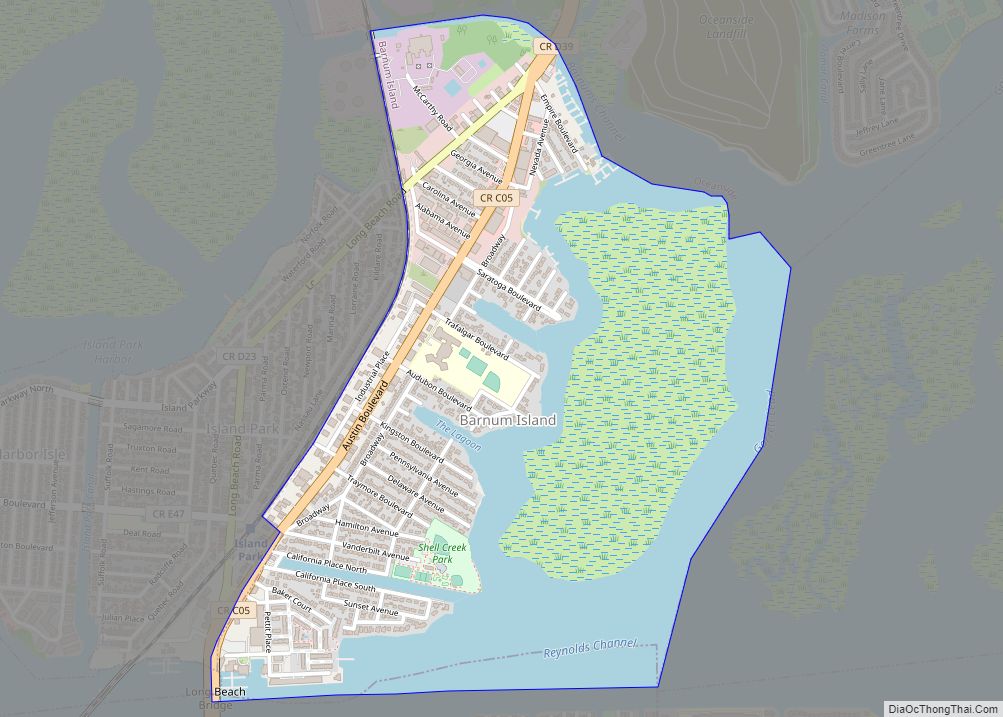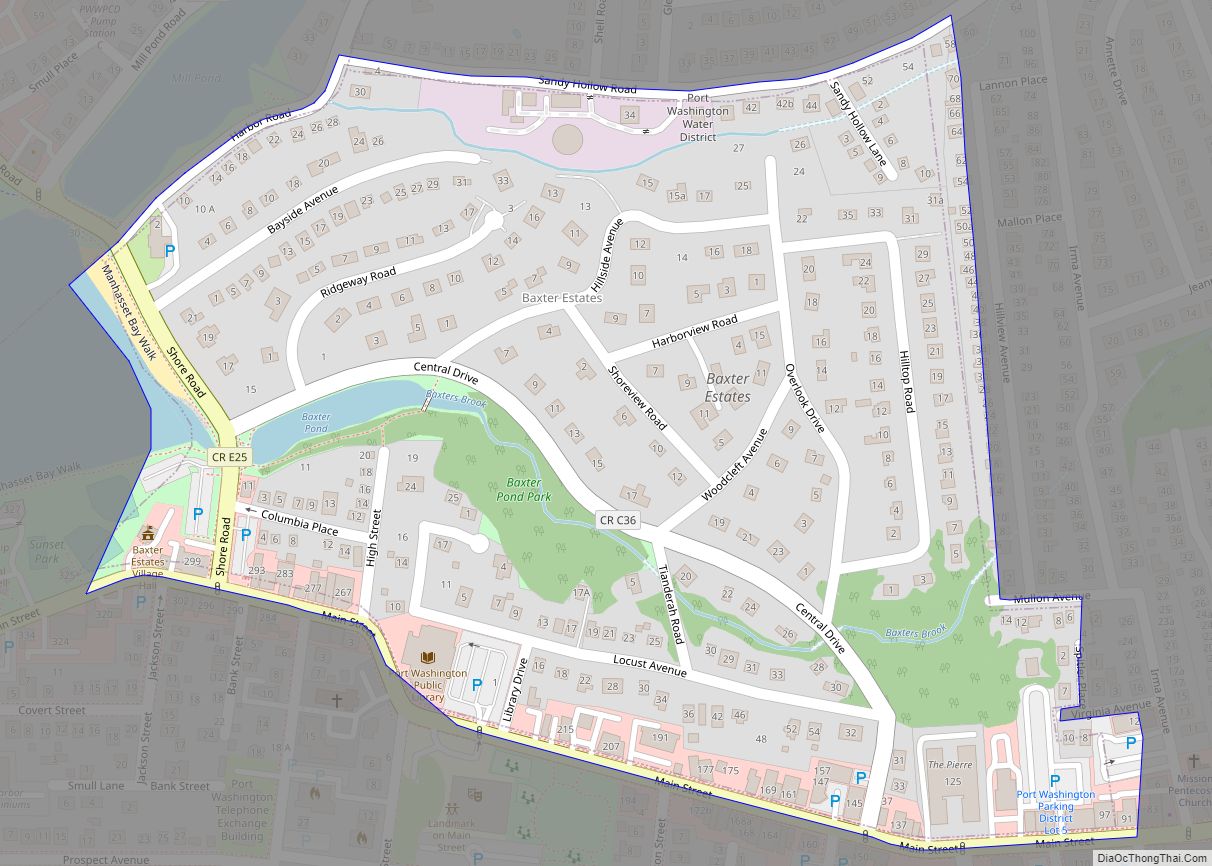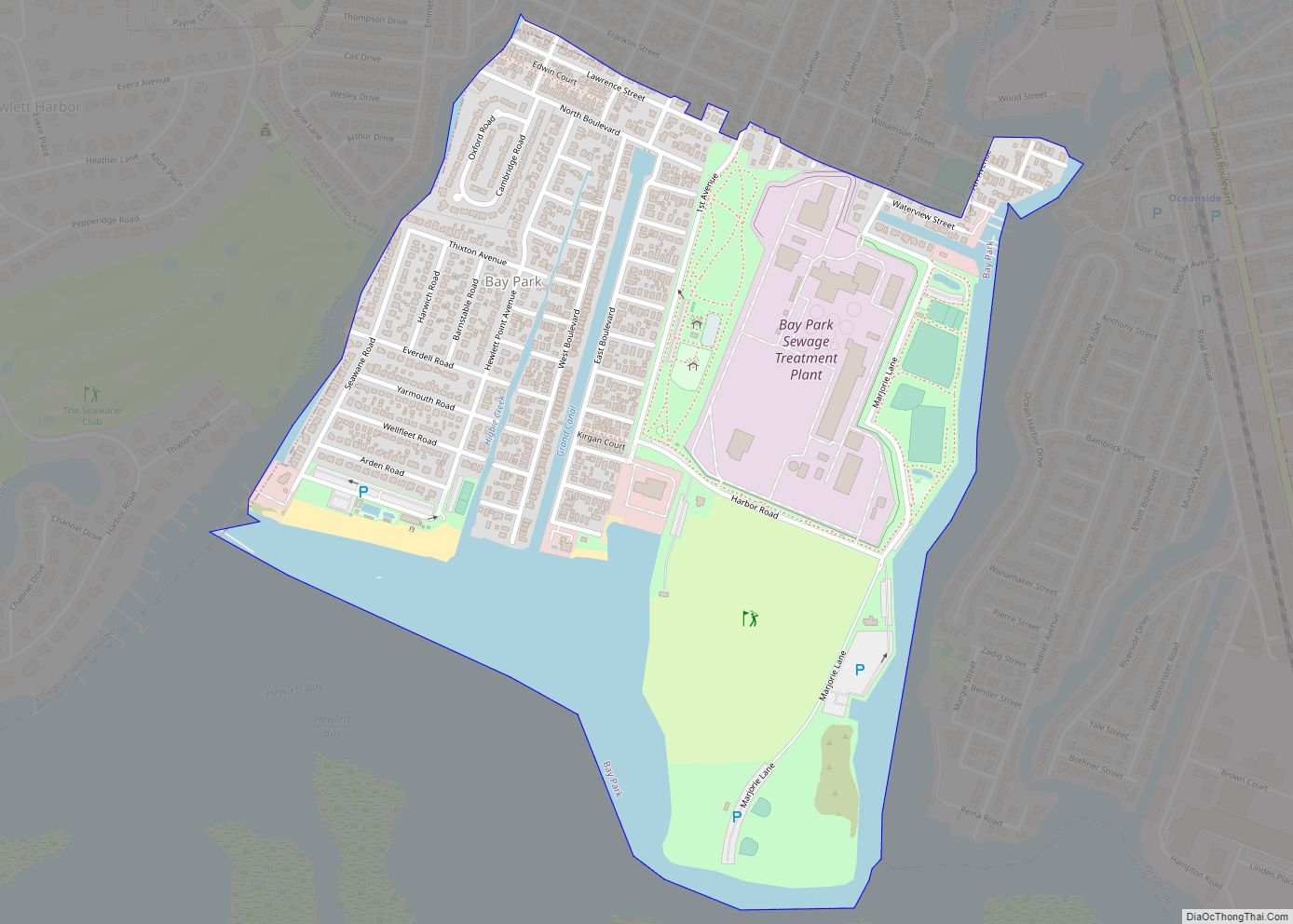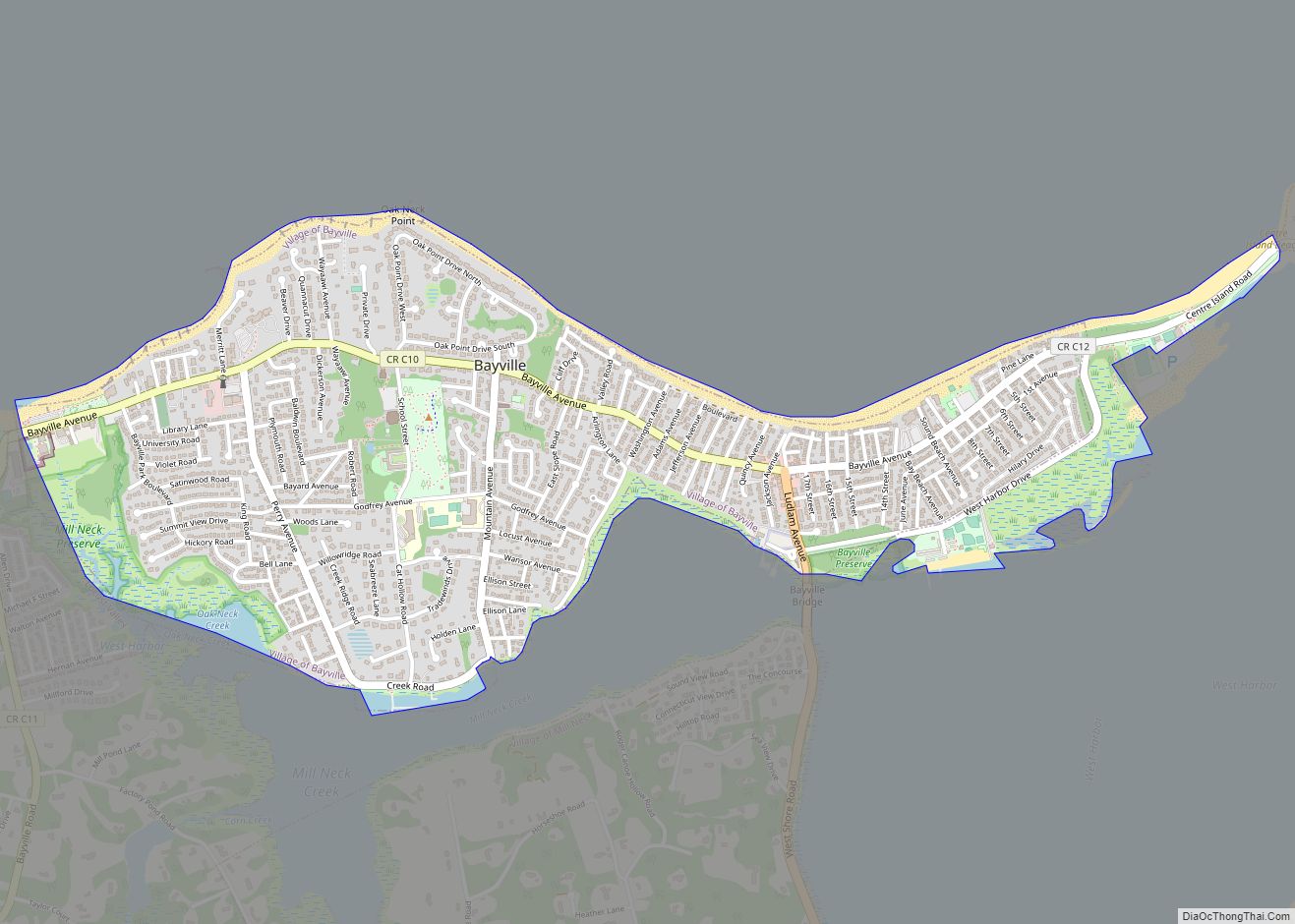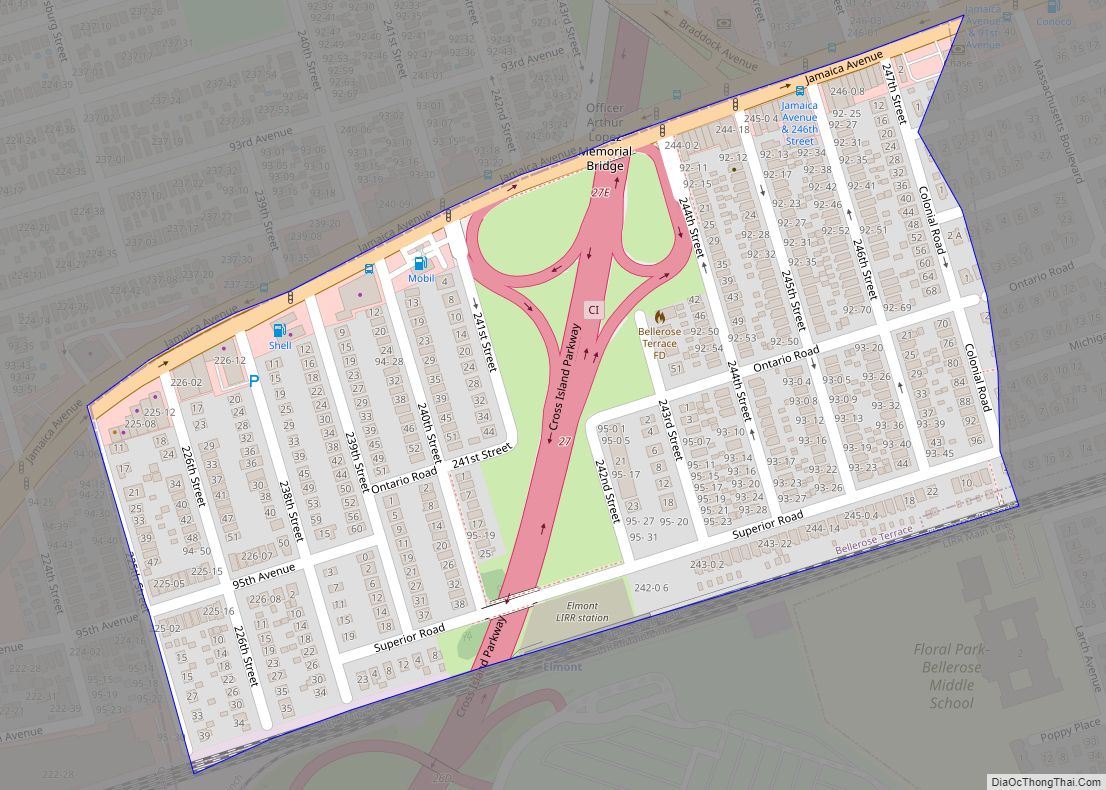Garden City is a village located on Long Island in Nassau County, New York, United States. It is the Greater Garden City area’s anchor community. The population was 23,272 at the 2020 census.
The Incorporated Village of Garden City is primarily located within the Town of Hempstead, with the exception being a small area at the northern tip of the village located within the Town of North Hempstead.
| Name: | Garden City village |
|---|---|
| LSAD Code: | 47 |
| LSAD Description: | village (suffix) |
| State: | New York |
| County: | Nassau County |
| Incorporated: | 1919 |
| Elevation: | 89 ft (27 m) |
| Total Area: | 5.36 sq mi (13.87 km²) |
| Land Area: | 5.33 sq mi (13.80 km²) |
| Water Area: | 0.03 sq mi (0.07 km²) |
| Total Population: | 23,272 |
| Population Density: | 4,367.87/sq mi (1,686.39/km²) |
| ZIP code: | 11530 |
| FIPS code: | 3628178 |
| GNISfeature ID: | 0950875 |
| Website: | www.gardencityny.net |
Online Interactive Map
Click on ![]() to view map in "full screen" mode.
to view map in "full screen" mode.
Garden City location map. Where is Garden City village?
History
Early years
In 1869, Irish-born millionaire Alexander Turney Stewart bought a portion of the lightly populated Hempstead Plains. In a letter, Stewart described his intentions for Garden City:
The central attraction of the new community was the Garden City Hotel. It was replaced by a new hotel in 1895, designed by the acclaimed firm of McKim, Mead & White. This hotel was destroyed by fire in 1899 and then rebuilt and expanded, before being replaced again in 1983. The hotel still stands on the original grounds, as do many nearby Victorian homes. Access to Garden City was provided by the Central Railroad of Long Island, another Stewart project which he undertook at the same time. This railroad, in conjunction with the Flushing & North Side Railroad, ran from Long Island City through Garden City to Farmingdale (with a spur to the location of the Stewart’s brickworks in Bethpage), and then to Babylon. It opened in 1873, with a branch to Hempstead.
Stewart’s wife, Cornelia, founded the Cathedral Schools of St. Paul (for boys) and St. Mary (for girls), a Bishop’s Residence and the Gothic Cathedral of the Incarnation, which is today the center of the Episcopal Diocese of Long Island, as well as the final resting place of Alexander Turney Stewart and Cornelia Stewart. This elaborate memorial was completed in 1885. Mrs. Stewart died the following year. In 2008, the Cathedral of the Incarnation underwent a multimillion-dollar renovation and rehabilitation project, which was completed in 2012.
Voters selected Mineola (in the town of North Hempstead) to be the county seat for the new county of Nassau in November 1898 (before Mineola incorporated as a village in 1906 and set its boundaries), winning out over Hicksville and Hempstead. The Garden City Company (founded in 1893 by the heirs of Alexander Turney Stewart) donated 4 acres (1.6 ha) of land for the county buildings just south of the Mineola train station and the present-day Incorporated Village of Mineola, in the Town of Hempstead. The land and the buildings have a Mineola postal address but are within the present-day village of Garden City, which did not incorporate, or set its boundaries, until 1919. The early village did well due to its proximity to Hempstead, which was at that time the commercial center of Long Island. In time, thanks to the railroad and to automobiles, as well, Garden City’s population increased.
In its early years, the press referred to Garden City as “Stewart’s Folly” due to the lack of residents that Stewart had envisioned would populate his project.
20th century
In 1910, Doubleday, Page, and Co., one of the world’s most important publishers, moved its operations to the east side of Franklin Avenue and had its own train station called Country Life Press added nearby. The Doubleday company purchased much of the land on the west side of Franklin Avenue, and built estate homes for many of its executives on Fourth Street. In 1916, company co-founder and Garden City resident Walter Hines Page was named Ambassador to Great Britain.
The area to the west of Garden City, named Garden City Estates, was established in 1907. It was merged with Garden City with both incorporated as the Village of Garden City in 1919. Garden City’s growth promoted the development of many nearby towns, including Stewart Manor, Garden City Park, Garden City South and East Garden City.
The Village is home to three golf courses, the first having been laid out under the direction of Devereux Emmet in 1896, now called the Garden City Golf Club. Subsequently, the now-named Cherry Valley Club (originally Salisbury Club) and Garden City Country Club were opened. For a short time in the late 1920s a fourth course existed, the Old Westbury Golf Club (initially the Intercollegiate Golf Club), east of Clinton Road.
Aviation played a big role in the history of the Village. The Nassau Boulevard Aerodrome, west of the Estates section, hosted the Second International Aviation Meet in 1911, which featured the first official airmail service. Other airfields included the Washington Avenue Field and the Hempstead Aerodrome, which ultimately became Roosevelt Field before being replaced by the Roosevelt Field Mall in the 1950s.
In the 1920s, the community continued to grow, with houses built in Garden City Estates as well as the eastern section of Garden City. Housing construction slowed after the 1929 stock market crash. But in the 1930s, hundreds of houses were built to accommodate a population boom, though Garden City used a strict zoning code to preserve Stewart’s vision. The Village retained a sense of orderly development, true to its rigorously planned roots.
Starting in the 1930s many branches of well-known New York City stores, including Best & Co., Saks Fifth Avenue, Bloomingdale’s and Lord & Taylor, opened along Franklin Avenue; earning the name “Fifth Avenue of Long Island.” All of these have subsequently closed due to relocation to nearby Roosevelt Field Mall or closure. The large buildings have been rebuilt as office space.
After World War II, following a trend of urban residents moving to the suburbs, Garden City continued to grow. Post-war construction filled out the present borders of Garden City with many split-level and ranch-style homes, with construction occurring in the town’s far eastern, northern and western sections. The Waldorf School of Garden City was founded in 1947 (one of the first Waldorf schools in the United States), originally as a part of Adelphi University. The village’s new public high school was also constructed in 1956, supplementing the original Cherry Valley school, which had opened in 1925.
The flat expanse of the land adjacent to Garden City allowed its use for military activities. For the Civil War, Camp Winfield Scott existed, for the Spanish-American War of 1898, Camp Black was established, and for World War I in 1917, Camp Albert Mills occupied land in the southeast part of the Village. Although Camp Mills was decommissioned after the war, the airbase Mitchel Field, which was established at the same time just east of the Village, existed until 1962.
In the 1960s, The World discotheque in Garden City featured multi-media supplied by USCO.
In the 1970s, the old Garden City Hotel declared bankruptcy and subsequently closed, and was ultimately demolished in 1973. A new Garden City Hotel was constructed on the site of the old Garden City Hotel. In 1978, fifty of the original structures collectively known as the A. T. Stewart Era Buildings were designated a national historic district and listed on the National Register of Historic Places.
In 1989, St. Paul’s School also closed and in 1993 was purchased by the Village of Garden City, eventually designating St. Paul’s and its property as “park land. St. Mary’s School, the sister school of St. Paul’s, was demolished in 2002. Since then, six large single-family houses have been built on the property.
Garden City has its own police department and volunteer fire department. Fire operations are conducted from three fire houses across the Village.
The Garden City Public Library, first established in 1952 as a volunteer service, now serves its residents from its building erected in 1973.
The Department of Recreation and Parks maintains many programs for Village residents, and operates the Community Pool in the Summer months. The Senior Center is used by all ages for meetings and recreational activities. In addition, this Commission is responsible for the maintenance of the trees located on streets and municipal property. One of the most important features of the Village is the prohibition of power lines on most streets, allowing the proper development of its street trees.
The Department of Public Works is responsible for the upkeep of the Village. Its equipment is maintained by its own staff at its municipal garage. It provides garbage and rubbish collection, water service, and street maintenance including snow plowing.
On December 7, 1993, the Long Island Rail Road’s Merillon Avenue station, which is located within the village, was the location of the Long Island Rail Road massacre in which six people were murdered and 19 injured in a racially motivated mass shooting perpetrated by Colin Ferguson, a black Jamaican immigrant.
Garden City lost 23 residents during the attack on the World Trade Center on September 11, 2001. Every year on the anniversary of the attack, the Garden City Fire Department holds a remembrance ceremony. A bell tolls after the reading of each of the 23 residents’ names, which are etched in the memorial monument stone on the Village Green.
Garden City Road Map
Garden City city Satellite Map
Geography
According to the U.S. Census Bureau, the village has a total area of 5.3 square miles (13.8 km), all land. The village lost some territory between the 1990 census and the 2000 census.
Garden City is located approximately 18.5 miles (29.8 km) east of Midtown Manhattan in New York City.
Greater Garden City area
In addition to the Incorporated Village of Garden City, the Garden City 11530 ZIP code includes another incorporated village, Stewart Manor, as well as two unincorporated areas of the Town of Hempstead: Garden City South and East Garden City – the latter of which was absorbed by the CDP of Uniondale in the 2010s.
See also
Map of New York State and its subdivision:- Albany
- Allegany
- Bronx
- Broome
- Cattaraugus
- Cayuga
- Chautauqua
- Chemung
- Chenango
- Clinton
- Columbia
- Cortland
- Delaware
- Dutchess
- Erie
- Essex
- Franklin
- Fulton
- Genesee
- Greene
- Hamilton
- Herkimer
- Jefferson
- Kings
- Lake Ontario
- Lewis
- Livingston
- Madison
- Monroe
- Montgomery
- Nassau
- New York
- Niagara
- Oneida
- Onondaga
- Ontario
- Orange
- Orleans
- Oswego
- Otsego
- Putnam
- Queens
- Rensselaer
- Richmond
- Rockland
- Saint Lawrence
- Saratoga
- Schenectady
- Schoharie
- Schuyler
- Seneca
- Steuben
- Suffolk
- Sullivan
- Tioga
- Tompkins
- Ulster
- Warren
- Washington
- Wayne
- Westchester
- Wyoming
- Yates
- Alabama
- Alaska
- Arizona
- Arkansas
- California
- Colorado
- Connecticut
- Delaware
- District of Columbia
- Florida
- Georgia
- Hawaii
- Idaho
- Illinois
- Indiana
- Iowa
- Kansas
- Kentucky
- Louisiana
- Maine
- Maryland
- Massachusetts
- Michigan
- Minnesota
- Mississippi
- Missouri
- Montana
- Nebraska
- Nevada
- New Hampshire
- New Jersey
- New Mexico
- New York
- North Carolina
- North Dakota
- Ohio
- Oklahoma
- Oregon
- Pennsylvania
- Rhode Island
- South Carolina
- South Dakota
- Tennessee
- Texas
- Utah
- Vermont
- Virginia
- Washington
- West Virginia
- Wisconsin
- Wyoming
